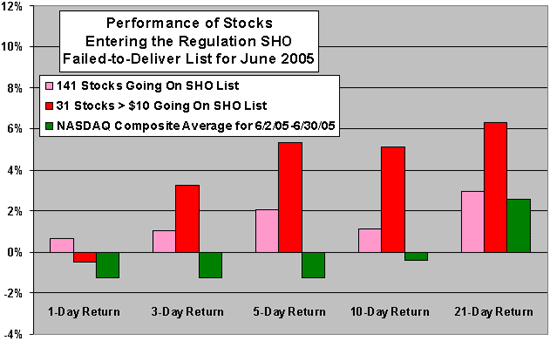What happens to stocks going on the NASDAQ Regulation SHO threshold list during. Does going on the list inhibit further short sales because (more than) all available shares have already been borrowed, allowing price to drift upward? Does it indicate that shorting has been overdone? Or, does appearance on the list scare off potential buyers, driving price lower? Using the daily NASDAQ threshold lists for June 2005 and contemporaneous daily stock price data from Yahoo! Finance, we find that:
We assume that by June the threshold list maintenance process has matured since first implemented at the beginning of 2005. We find that:
- 383 securities appear on the NASDAQ threshold list during June 2005.
- There are 197 instances of stocks entering the list during the month (two stocks enter twice).
- 141 of the 197 instances involve stocks priced less than $5 at the time they enter the list (or currently if no historical data is available). Many of these low-price stocks are OTC or Pink Sheet issues.
- 32 of the 197 instances involve stocks priced over $10 at the time they enter the list.
- Yahoo! Finance has historical price data for the stocks involved in 141 of the 197 instances. Many of those stocks without historical data have current prices below $0.25.
- Of the 141 stocks entering the list for which there is historical price data, 47 exit the list by the end of the month.
The pink bars on the chart below show the average returns for all 141 stocks for which Yahoo! Finance has historical price data at 1 day, 3 days, 5 days, 10 days and 21 days after they enter the NASDAQ threshold list during June 2005. The red bars show the average returns for the 31 out of the 141 that have prices of at least $10 when they enter the list. The green bars show, for comparison, the average returns over the same intervals for the NASDAQ Composite index for all days from June 2 through June 30.
Results suggest that prices rebound for stocks as they enter the NASDAQ threshold list, perhaps because further shorting is inhibited or shorting is already overdone. Standard deviations for the bigger sample of 141 stocks are very large compared to the average returns. Standard deviations for the 31-stock subset with prices over $10 are large in the short term and moderate in the intermediate term compared to the average returns, and the sample size for this subset is modest.

In summary, excess returns of the higher-priced stocks entering the Regulation SHO threshold list merit some consideration.